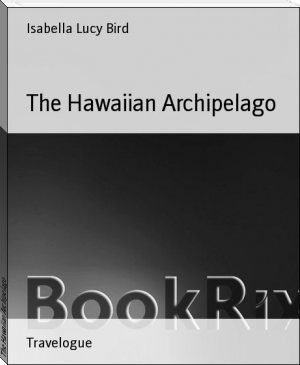The Hawaiian Archipelago by Isabella Lucy Bird (librera reader txt) 📖

- Author: Isabella Lucy Bird
Book online «The Hawaiian Archipelago by Isabella Lucy Bird (librera reader txt) 📖». Author Isabella Lucy Bird
The Educational System has been carefully modelled, and is carried out with tolerable efficiency. Eighty-seven per cent. of the whole school population are actually at school, and the inspector of schools states that a person who cannot read and write is rarely met with. Each common school is graded into two, three, or four classes, according to the intelligence and proficiency of the pupils, and the curriculum of study is as follows:--
CLASS I.--Reading, mental and written arithmetic, geography, penmanship, and composition.
CLASS II.--Reading, mental arithmetic, geography, penmanship.
CLASS III.--Reading, first principles of arithmetic, penmanship.
CLASS IV.--Primer, use of slate and pencil.
The youngest children are not classified until they can put letters together in syllables.
Vocal music is taught wherever competent teachers are found.
The total sum expended on education, including the grants to "family" and other schools, is about $40,000 a year. {453}
It has been remarked that the rising race of Hawaiians has an increased contempt for industry in the form of manual labour, and it is proposed by the Board of Education that such labour shall be made a part of common school education, so that on both girls and boys a desire to provide for their own wants in an honest way shall be officially inculcated. There is a Government Reformatory School, and industrial and family schools for both girls and boys are scattered over the islands. The supply of literature in the vernacular is meagre, and few of the natives have any intelligent comprehension of English.
The group has an area of about 4,000,000 acres, of which about 200,000 may be regarded as arable, and 150,000 as specially adapted for the culture of sugar-cane. Sugar, the great staple production, gives employment in its cultivation and manufacture to nearly 4,000 hands. Only a fifteenth part of the estimated arable area is under cultivation. Over 6,000 natives are returned as the possessors of Kuleanas or freeholds, but many of these are heavily mortgaged. Many of the larger lands are held on lease from the crown or chiefs, and there are difficulties attending the purchase of small properties.
Almost all the roots and fruits of the torrid and temperate zones can be grown upon the islands, and the banana, kalo, yam, sweet potato, cocoanut, breadfruit, arrowroot, sugar-cane, strawberry, raspberry, whortleberry, and native apple, are said to be indigenous.
The indigenous fauna is small, consisting only of hogs, dogs, rats, and an anomalous bat which flies by day: There are few insects, except such as have been imported, and these, which consist of centipedes, scorpions, cockroaches, mosquitoes, and fleas, are happily confined to certain localities, and the two first have left most of their venom behind them. A small lizard is abundant, but snakes, toads, and frogs have not yet effected a landing.
The ornithology of the islands is scanty. Domestic fowls are supposed to be indigenous. Wild geese are numerous among the mountains of Hawaii, and plovers, snipe, and wild ducks, are found on all the islands. A handsome owl, called the owl-hawk, is common. There is a paroquet with purple feathers, another with scarlet, a woodpecker with variegated plumage of red, green, and yellow, and a small black bird with a single yellow feather under each wing. There are few singing birds, but one of the few has as sweet a note as that of the English thrush. There are very few varieties of moths and butterflies.
The flora of the Hawaiian Islands is far scantier than that of the South Sea groups, and cannot compare with that of many other tropical as well as temperate regions. But all the islands are rich in cryptogamous plants, of which there is an almost infinite variety.
Hawaii is still in process of construction, and is subject to volcanic eruptions, earthquakes, and tidal waves. Hurricanes are unknown, and thunderstorms are rare and light.
Under favourable circumstances of moisture, the soil is most prolific, and "patch cultivation" in glens and ravines, as well as on mountain sides, produces astonishing results. A Kalo patch of forty square feet will support a man for a year. An acre of favourably situated land will grow a thousand stems of bananas, which will produce annually ten tons of fruit. The sweet potato flourishes on the most unpromising lava, where soil can hardly be said to exist, and in good localities produces 200 barrels to the acre. On dry light soils the Irish potato grows anyhow and anywhere, with no other trouble than that of planting the sets. Most vegetable dyes, drugs, and spices can be raised. Forty diverse fruits present an overflowing cornucopia. The esculents of the temperate zones flourish. The coffee bush produces from three to five pounds of berries the third year after planting. The average yield of sugar is two and a half tons to the acre. Pineapples grow like weeds in some districts, and water melons are almost a drug. The bamboo is known to grow sixteen inches in a day. Wherever there is a sufficient rainfall, the earth teems with plenty.
Yet the Hawaiian Islands can hardly be regarded as a field for emigration, though nature is lavish, and the climate the most delicious and salubrious in the world. Farming, as we understand it, is unknown. The dearth of insectivorous birds seriously affects the cultivation of a soil naturally bounteous to excess. The narrow gorges in which terraced "patch cultivation," is so successful, offer no temptations to a man with the world before him. The larger areas require labour, and labour is not to be had. Though wheat and other cereals mature, attacks of weevil prevent their storage, and all the grain and flour consumed are imported from California.
Cacao, cinnamon, and allspice, are subject to an apparently ineradicable blight. The blight which has attacked the coffee shrub is so severe, that the larger plantations have been dug up, and coffee is now raised by patch culture, mainly among the guava scrub which fringes the forests. Oranges suffer from blight also, and some of the finest groves have been cut down. Cotton suffers from the ravages of a caterpillar. The mulberry tree, which, from its rapid growth, would be invaluable to silk growers, is covered with a black and white blight. Sheep are at present successful, but in some localities the spread of a pestilent "oat-burr" is depreciating the value of their wool. The forests, which are essential to the well-being of the islands, are disappearing in some quarters, owing to the attacks of a grub, as well as the ravages of cattle.
Cocoanuts, bananas, yams, sweet potatoes, kalo, and breadfruit, the staple food of the native population, are free from blight, and so are potatoes and rice. Beef cattle can be raised for almost nothing, and in some districts beef can be bought for the cent or two per pound which pays for the cutting up of the carcase. Every one can live abundantly, and without the "sweat of the brow," but few can make money, owing to the various forms of blight, the scarcity of labour, and the lack of a profitable market.
There is little healthy activity in any department of business. The whaling fleet has deserted the islands. A general pilikia prevails. Settlements are disappearing, valley lands are falling out of cultivation, Hilo grass and guava scrub are burying the traces of a former population. The natives are rapidly diminishing, {457} the old industries are abandoned, and the inherent immorality of the race, the great outstanding cause of its decay, still resists the influence of Christian teaching and example.
An exotic civilization is having a fair trial on the Hawaiian Islands. With the exception of the serious maladies introduced by foreigners in the early days, and the disastrous moral influence exercised by worthless whites, they have suffered none of the wrongs usually inflicted on the feebler by the stronger race. The rights of the natives were in the first instance carefully secured to them, and have since been protected by equal laws, righteously administered. The Hawaiians have been aided towards independence in political matters, and the foreigners, who framed the laws and constitution, and have directed Hawaiian affairs, such as Richards, Lee, Judd, Allen, and Wyllie, were men above reproach; and missionary influence, of all others the most friendly to the natives, has predominated for fifty years.
The effects of missionary labour have been scarcely touched upon in the foregoing letters, and here, in preference to giving any opinion of my own, I quote from Mr. R. H. Dana, an Episcopalian, and a barrister of the highest standing in America, well known in this country by his writings, who sums up his investigations on the Sandwich Islands in the following dispassionate words:
"It is no small thing to say of the missionaries of the American Board, that in less than forty years they have taught this whole people to read and to write, to cipher and to sew. They have given them an alphabet, grammar, and dictionary; preserved their language from extinction; given it a literature, and translated into it the Bible, and works of devotion, science, and entertainment, etc. They have established schools, reared up native teachers, and so pressed their work, that now the proportion of inhabitants who can read and write is greater than in New England. And whereas they found these islanders a nation of half-naked savages, living in the surf and on the sand, eating raw fish, fighting among themselves, tyrannized over by feudal chiefs, and abandoned to sensuality, they now see them decently clothed, recognizing the law of marriage, knowing something of accounts, going to school and public worship more regularly than the people do at home, and the more elevated of them taking part in conducting the affairs of the constitutional monarchy under which they live, holding seats on the judicial bench and in the legislative chambers, and filling posts in the local magistracies."
If space permitted, the testimony of "Mark Twain," given in "Roughing It," might be added to the above, and the remaining missionaries may well point to the visible results of their labours, with the one word Circumspice!
A CHAPTER ON HAWAIIAN HISTORY.
In the pre-historic days of Hawaii, for 500 years, as the bards sing, before Captain Cook landed, and indeed for some years afterwards, each island had its king, chiefs, and internal dissensions; and incessant wars, with a reckless waste of human life, kept the whole group in turmoil. Chaotic and legendary as early Hawaiian history is, there is enough to show that there must have been regularly organized communities on the islands for a very long period, with a civilization and polity which, though utterly unworthy of Christianity, were enlightened and advanced for Polynesian heathenism.
The kingly office was hereditary, and the king's power absolute. On the different islands the kings and chiefs who together constituted a privileged class, admitted the priesthood to some portion of their privileges, probably with the view of enslaving the people more completely through the agency of religion, and held the lower classes in absolute subserviency by the most





Comments (0)